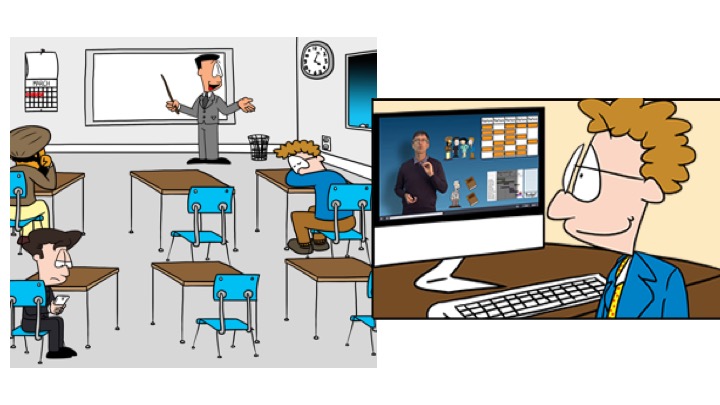
Note: I wrote this blog last year just after the Agile 2019 conference in August 2019. While interest in virtual consulting and training was finally moving from the fringes and into the mainstream, I thought it would be still at least 3 to 5 years before widespread adoption of virtual training and consulting. What a difference 9 months make. Now virtual could be the main service delivery mechanism as virtual work becomes the new normal. Tobias Lutke, CEO of the Canadian tech superstar Shopify said it simply, “…this is the end of office centricity”
The Agile Alliance “Agile” conference is arguably the premier agile conference. Each year some 2500 people gather together to learn, to see and be seen, to share ideas, and even share a few ideas over a few drinks. The “Agile” conferences are great places to catch the pulse of the industry. Of course, business agility is the hot topic these days, but one undercurrent that really caught my attention this year at Agile 2019 in Washington DC, was the rising interest in online or virtual consulting and training. For the first time that I was aware of, there was a real buzz about delivering agile training and consulting services online. Not as a cheap substitute for development teams in far off lands, or those who do not apparently warrant “the luxury of in-person delivery” but rather as a legitimate and perhaps superior way of delivering services.
I was at agile to deliver an experience report which told the story of how we leveraged online assets to give everyone on a large globally distributed SAFe solution train an equal voice in the SAFe problem solving workshop. If you are interested in our experience report, you can find it at the agile alliance website “The Sun Never Sets on the Problem Solving Workshop”. https://www.agilealliance.org/resources/experience-reports/. Our experience report was followed immediately by Joe Fecarotta of Accenture/SolutionsIQ who explained how he is successfully training and coaching Accenture staff online. Later Shane Hastie of IC-Agile (icagile.com) lead a session on Training from the Back of the Room (TFTBR) online. For those not familiar with TFTBR, these are practices which move the instructor away from the classic “talking head, death by power point” model of course delivery to a more participative learning model. Take a look at Sharon Bowman’s website https://bowperson.com/training-from-the-back-of-the-room/; if this interests you, and it should if you are doing any kind of training. Shane’s session was about developing practices for developing online participative models that are consistent with the TFTBR principles. Looking around the well-attended session I noticed many agile coaches whom I consider thought leaders in our industry. Simply, virtual training is moving from the fringes to the mainstream.
I am convinced the time for virtual training and consulting has come for many reasons. First simply the collaboration technology has gotten way better. We have always believed that face to face is conversations are best, and in absolute terms this is true. However, online is beginning to offer a fair approximation of a face to face conversation. When the manifesto was written in 2001, the Internet and online collaboration technology were in their infancy. In 2001 I had dial up for access. Now I have 300Mbits/sec coming into my house. It’s not just speed, it’s also the resolution of the HTML5 standards wars which means there are now amazing online collaborative tools. Second product development and especially software development is a global industry, and regular in person face to face meetings are often impractical. Third the millennials – sorry guys, I know you hate us old boomers referring to you this way – are moving into leadership roles and with them there is a major organizational change in attitude towards online collaboration. These are people who grew up in an online environment and are totally comfortable working there. I often like to joke if educated and experienced engineers could do what my daughter does in Minecraft I would be out of a job – seriously, if you have kids watch them playing Minecraft. Fourth is cost, easily 20 to 25% of the cost of a consulting engagement is expenses. Either my customer would like to save that 20-25% or I would like to have that 20 to 25% go into my pocket rather than Air Canada’s and Marriott’s. But it’s not just monetary cost. It is also the physical and social costs on the people who have to regularly travel to deliver those services. There are fewer and fewer people who are willing to travel.
Given all this we have to ask, is it really necessary to have a coach or trainer onsite day after day, week after week? Recently a family issue prevented me from traveling to a coaching engagement, so I executed the engagement for the week using a variety of collaboration tools like Slack. In our opinions, I was just as effective working from home as if I had been onsite. Of course, I had already established a strong personal relationship with my client because I had previously been onsite. However, this was a clear indicator that I did not need to be physically onsite every week. Furthermore, I am currently working a completely online engagement with a client where we are successfully launching a number of Scrum teams. We have delivered the all the training and coaching online. Of course, as per Shane Hastie’s Agile 2019 session, we had to re-design our course delivery style to leverage the online capabilities, but we were still able to deliver an interactive and engaging experience. Trainers and coaches do not need to be onsite week after week after week to successfully deliver services.
Finally, and most importantly there is an environmental reason for moving more of our work online and that is the carbon footprint for air travel. While air travel only contributes between 2 to 3 % of green house gasses, it is the small cadre of frequent flyers like myself who make up the bulk of airline passenger. For me it’s a bit of a personal paradox because I try to live a low carbon lifestyle. I don’t own a car, I mostly use transit or ride a bicycle. Then every week I fly across the North American continent expelling the equivalent of a year’s worth of driving in green house gasses. It is not hard to notice there is already a backlash starting against excessive air travel. Some academics in Scandinavian countries now have to justify their carbon budget if they choose to travel to a conference. It would not surprise me that if in 5 years frequent flyers like myself will be frowned upon much in the same way as smokers were.
I want to leave something behind for my children, and if I can reduce my carbon footprint, reduce costs to my client, be in my own bed at night, and deliver as good or better experience then I am all for it. It’s time to follow our children’s leadership and join them online.
